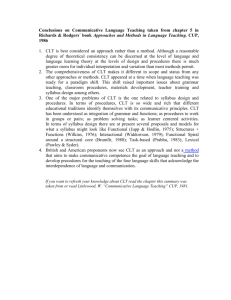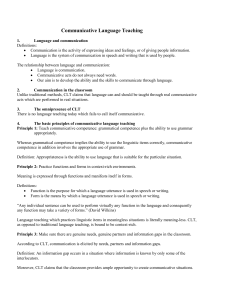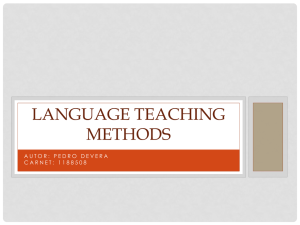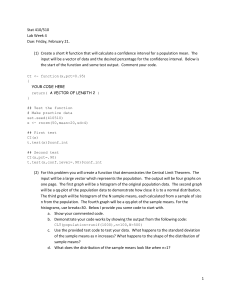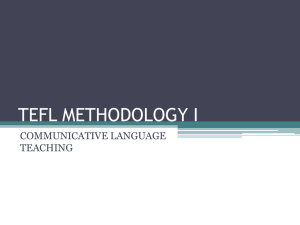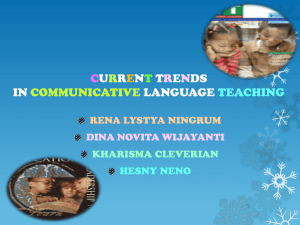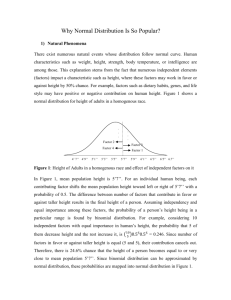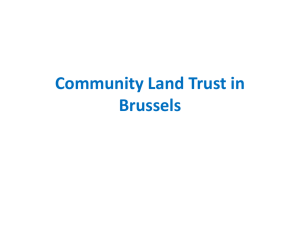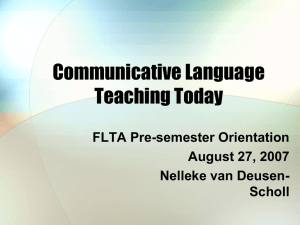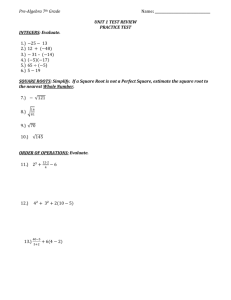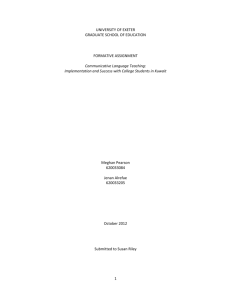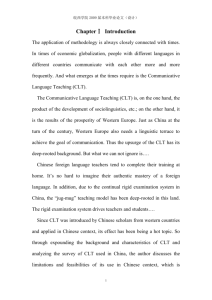Peer Teaching 611 - apling611-s12-kiss
advertisement
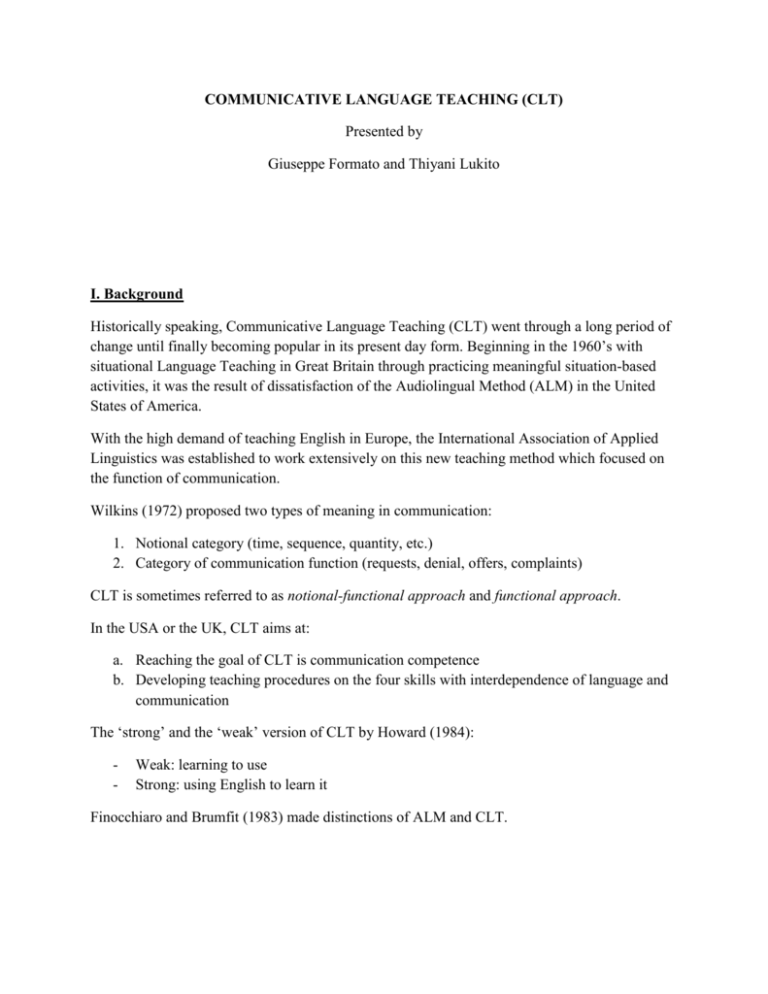
COMMUNICATIVE LANGUAGE TEACHING (CLT) Presented by Giuseppe Formato and Thiyani Lukito I. Background Historically speaking, Communicative Language Teaching (CLT) went through a long period of change until finally becoming popular in its present day form. Beginning in the 1960’s with situational Language Teaching in Great Britain through practicing meaningful situation-based activities, it was the result of dissatisfaction of the Audiolingual Method (ALM) in the United States of America. With the high demand of teaching English in Europe, the International Association of Applied Linguistics was established to work extensively on this new teaching method which focused on the function of communication. Wilkins (1972) proposed two types of meaning in communication: 1. Notional category (time, sequence, quantity, etc.) 2. Category of communication function (requests, denial, offers, complaints) CLT is sometimes referred to as notional-functional approach and functional approach. In the USA or the UK, CLT aims at: a. Reaching the goal of CLT is communication competence b. Developing teaching procedures on the four skills with interdependence of language and communication The ‘strong’ and the ‘weak’ version of CLT by Howard (1984): - Weak: learning to use Strong: using English to learn it Finocchiaro and Brumfit (1983) made distinctions of ALM and CLT. II. Approach Theory of language Communicative approach starts from theory of language as communication. Dell Hymes (1972) developed language teaching into ‘Communicative Competence’ (CC) which incorporated language and culture (what the language entails). CC developed out of Chomsky’s (1965) theory of competence. Canal and Swain (1980) conceptualized the four dimensions of CC: 1. 2. 3. 4. Grammatical competence Sociolinguistic competence Discourse competence Strategic competence Theory of language that promotes CLT learning (R&R): 1. Communication principle: real communication activities 2. Task principle: meaningful task activities (Johnson, 1982) 3. Meaningfulness principle: meaningful language for learners Krashen theory of learning: - Acquisition: unconscious development of L2 by using real communication Learning: conscious representation of grammatical structures Skill development in CLT (Johnson, 1984 & Littlewood, 1984): - Cognitive Behavioral Practice III. Design Objectives CLT objectives (Piepho, 1981): - Integrative and content Linguistic and instrumental Interpersonal Individual learning needs - General education The Syllabus Wilkins (1976) proposed the notional syllabus; “…specified the semantic-grammatical categories (e.g. frequency, motion, location) and the categories of communicative function that learners need to express” (p.163). It was criticized by British applied linguists Widdowson (1979). Types of syllabuses classified by Yaldens (1983): - Structure plus function (Wilkins, 1976) Functional spiral around a structural core (Brumfit, 1980) Structural, functional, instrumental (Allen, 1980) Functional (Jupp and Hodlin, 1975) Notional (Wilkins, 1976) Interactional (Widdowson, 1979) Task based (Prabhu, 1983) Learner-generated (Cadlin, 1976; Henner-Stachina and Riley, 1978) Types of learning and teaching activities - Showing out-of-focus slides to identify (Wright, 1976) Incomplete plans and diagrams to complete (Byrne, 1978) Communication behind the screen (Allwright, 1977) Jigsaws (Geddes and Sturtridge, 1979) Functional communication activities and social interaction activities (Littlewood, 1981) Learner roles - Negotiator between the self and should contribute as much as he gains (Breen and Candlin) Interact primarily with each other (not with teacher) (Henner-Stachina and riley, 1978) Cooperative (rather than individualistic) Teacher roles Teacher roles according to Breen and Cadlin (1980): - To facilitate the communication process between all participants in the classroom To act as an independent participant within the learning-teaching group To contribute appropriate knowledge and abilities, actual and observed experience of the nature of learning and organizational capacities Additional teacher roles (R&R): - Needs analyst Counselor Group process manager The role of instructional materials: - - Text-based materials: + a task analysis for thematic development + a practice situational description + a stimulus presentation + comprehension questions + paraphrase exercise Task-based materials (in pair communication) Realia (‘authentic’/from-life materials) IV. Procedure “…communication principle can be applied to the teaching of any skill, at any level…CLT procedures are evolutionary rather than revolutionary…” (Richards and Rodgers 170). “Traditional procedures are not rejected but are reinterpreted and extended. Teaching points are introduced in dialogue form, grammatical items are isolated for controlled practice, and then freer activities are provided. Pair and group work is suggested to encourage students to use and practice functions and forms” (Richards and Rodgers 171). Sequence of activities in CLT by Littlewood (1981): Pre-communicative activities Structural activities Quasi-communicative activities Communicative activities Functional communication activities Social interaction activities V. Conclusion CLT is an approach (not a method). Dimensions of CLT: 1. To develop syllabus that was compatible with the notion of communicative competence, rather than grammatical structures (Wilkins, 1976) 2. Focus on procedures for identifying learners’ needs (Munby, 1978) 3. Focus on classroom activities used as bases of communicative methodology (Prabhu, 1987) Five characteristic on the application of communicative methodology (Johnson, 1998): 1. 2. 3. 4. 5. Appropriateness Message focus Psycholinguistic processing Risk taking Free practice
